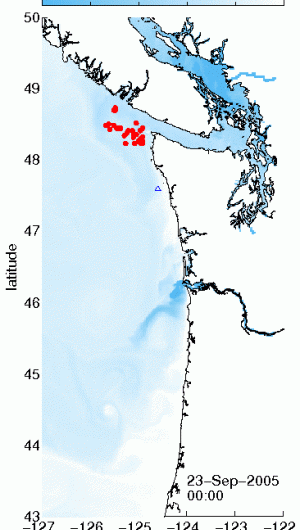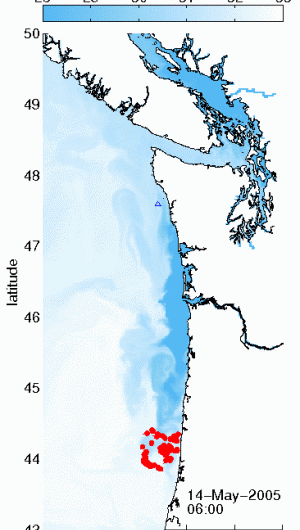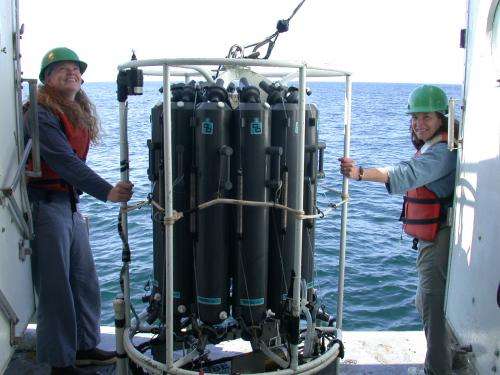Predicting when toxic algae will reach Washington and Oregon coasts

(Phys.org) —ate summer is the peak time for harmful algae that can turn lakes into toxic scum, canceling fishing trips and fouling water supplies. While the Pacific Northwest doesn't get anything near the activity that turned parts of Lake Erie into bright green slime, our coasts are vulnerable in late summer to this largely unpredictable – and in our case unseen – menace.
University of Washington oceanographers have created a tool to help predict when harmful algae might strike. A few days' warning could prevent last-minute beach closures or shellfish harvest losses, and reduce the risk of eating a clam filled with a neurotoxin that can lead to permanent short-term memory loss, or even death.
The researchers developed a computer model to track when harmful algae will get carried to Washington and Oregon beaches. A study published in April in the Journal of Geophysical Research shows the model, when fed the right data, could predict most of the toxic algae events recorded in field studies between 2004 and 2007.
The paper is part of a larger UW project to model and predict toxic algal blooms in the Pacific Northwest, involving years of research into how the blooms form offshore and travel to coastal waters.
Saltwater and freshwater algal blooms are different from each other, of course, and different regions of the country have unique situations.
"In Florida they have one species, not 12, and it's extremely predictable, it happens every year. And you can see those blooms from a satellite," said co-author Barbara Hickey, a UW professor of oceanography who has spent four decades studying Northwest coastal ocean currents. "Here you have to have an electron microscope to see these things."
In Washington, harmful algal blooms are a largely naturally occurring phenomenon that produce neurotoxins that can accumulate in razor clams, creating an economic and public-health concern.
Better predictions for when toxic algae might hit would prevent last-minute beach closures, and also could also give shellfish growers time to prepare and harvest clams before they become contaminated.
Hickey and co-author Vera Trainer at the National Oceanographic and Atmospheric Administration in Seattle previously used their combined knowledge and expertise to publish a weekly bulletin for predicting toxic events.

The computer model instead uses sensors that track the ocean conditions, then combines those with weather forecasts to generate an ocean prediction for the next few days. It harnesses recent advances in computing, as well as increasing knowledge of coastal currents and the conditions that lead to toxic algal blooms in this region.
UW research in 2005 had established a swirling mass of water off the coast between Washington and British Columbia, known as the Juan de Fuca eddy, as the major source for harmful algae that affect the Washington coast in summer and fall.
"For some reason when the cells get in there they can stay longer than in other places, and a lot of times they become toxic," Hickey said.
A 2013 paper by Hickey established a second source of harmful algal blooms, primarily in the spring, at Heceta Bank, a fishing area west of Eugene, Oregon.
"In the springtime the main currents are actually running in the other direction than in summer, and if you have a big storm, Heceta Bank also is a place where you can get the toxic algae coming from that area, and then moving up the coast, joining the Columbia River plume, and they end up impacting our fisheries in the springtime offshore of Willapa Bay and the Grays Harbor area," Hickey said.
Earlier work by Hickey had studied the freshwater plume emerging from the Columbia River at the Washington-Oregon border. The new model incorporates those observations to generate its predictions.
"We found that it's all important," Hickey said. "You have to get what's happening in Puget Sound and the Columbia River right to make the coastal ocean right."

The conditions must first be just right for toxic organisms to grow – a process that's still somewhat mysterious – and then reach local shores.
"It turns out there has to be quite a miraculous set of circumstances," Hickey said, for toxins to reach the beach. Foul weather must keep the eddy circulating long enough for the toxins to develop, then good weather lets them escape and float down the coast. A few days later, bad weather must develop to reverse the currents and push the algae toward the beach.
Tests of the model in the new paper confirmed that algae from the northern source reach the Washington coast in the late summer and early fall, and the southern source tends to reach the shore in the late winter and early spring. The wind direction determines the algae's path.
So far, this year has had few toxic blooms on Northwest coasts, another benefit of this summer's nice weather.
"If you have really good weather all the way until the October storms hit, you probably won't see any harmful algal blooms because they just get blown south to Oregon and blown off the coast," Hickey said. "If you have crummy summer weather, where the weather changes and the winds and the currents keep changing direction, then it's more likely to be hazardous for harmful algal blooms."
The first author of the paper introducing the model is Sarah Giddings, a former UW postdoctoral researcher and now a faculty member at the University of California, San Diego. Two upcoming companion papers will use the same model to focus on the biology (which organisms grow under what conditions) and the water chemistry (oxygen level, acidity and other variables).
Co-author Parker MacCready, a UW professor of oceanography, leads the UW group that's putting the short-term forecasts online. The tool, which will initially focus on ocean acidity and oxygen levels, is expected to be operational later this year.
More information: Giddings, S. N., P. MacCready, B. M. Hickey, N. S. Banas, K. A. Davis, S. A. Siedlecki, V. L. Trainer, R. M. Kudela, N. A. Pelland, and T. P. Connolly (2014), "Hindcasts of potential harmful algal bloom transport pathways on the Pacific Northwest coast," J. Geophys. Res. Oceans, 119, 2439–2461, DOI: 10.1002/2013JC009622.
Journal information: Journal of Geophysical Research
Provided by University of Washington

















